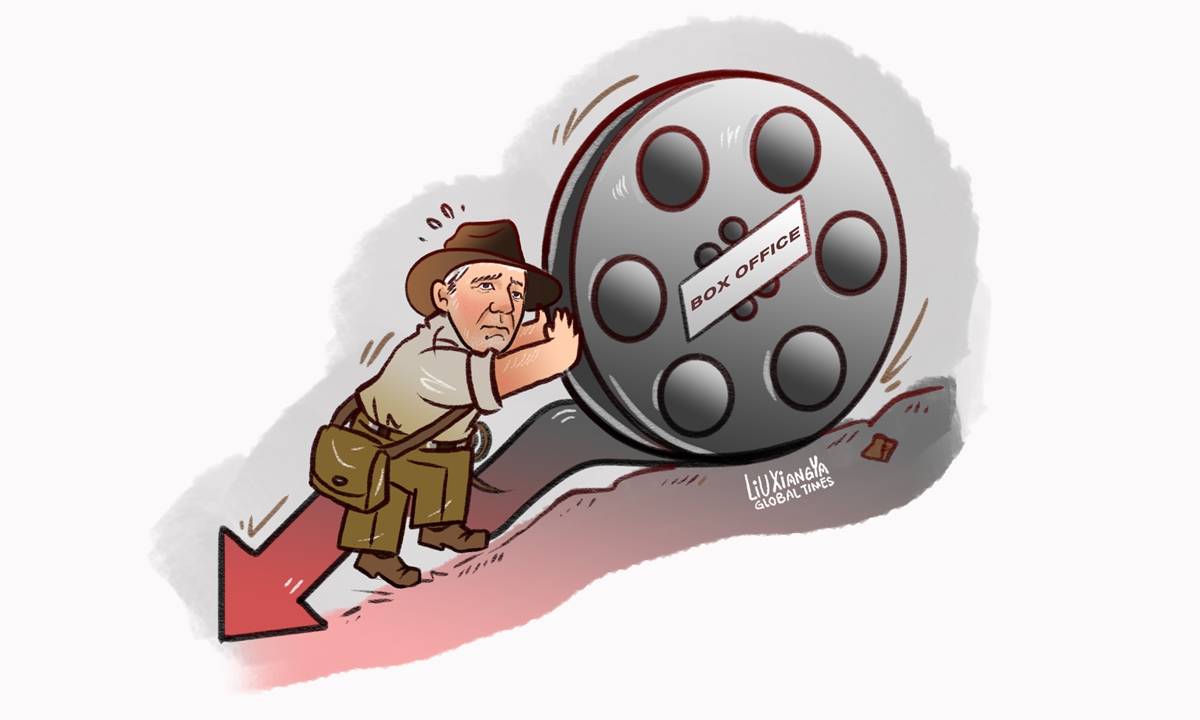LIFE / ATTITUDES
'Mission: Impossible 7' flop shows Hollywood's malaise

Illustration: Liu Xiangya/Global Times
The classic action movie Mission: Impossible series first opened in the Chinese film market in 2002, when director John Woo Yu-Sen's Mission: Impossible II, starring Tom Cruise, earned 25 million yuan ($3.5 million) at the Chinese box office, ranking eighth that year. In the following years, the series became extremely popular in China, accumulating numerous fans and achieving high box office numbers. For instance, Mission: Impossible III (2006) earned 81.2 million yuan, and Mission: Impossible - Fallout (2018), the sixth installment, grossed an impressive 1.245 billion yuan. Each film in the series showcased Tom Cruise's commitment to pushing boundaries with new and daring action sequences, all captured through practical, real-life filming techniques.
However, the latest installment, Mission: Impossible - Dead Reckoning Part One, released on July 14, has struggled at the Chinese box office. In over two weeks, it has only grossed 329 million yuan as of Monday, with its screen share dropping from 25.4 percent on its opening day to around 2 percent. It is predicted that total box office revenue will not exceed 400 million yuan. This underperformance is not limited to China alone; it extends to the global box office as well.
From the perspective of a standalone film, the 61-year-old Tom Cruise delivered an impressive performance: From racing through the streets of Rome driving a car with one hand, to cliff-jumping on a motorcycle, hanging perilously from a train, and executing precise parachute jumps within seconds. However, it seems Mission: Impossible 7 fails to satisfy the current audience's viewing preferences. The high-stakes action and challenging missions are no longer sufficient to meet their demands. Although the introduction of a new antagonist called "The Entity" attempts to tackle the hot topic of artificial intelligence gaining consciousness, this theme has become predictable and lacks innovative or futuristic elements. At a time when discussions surrounding AI are still fresh in people's minds, this villain fails to capture the audience's interest.
This is not an isolated case for Mission: Impossible 7, but rather another example of Hollywood's storytelling crisis. In recent years, Hollywood blockbusters have relied heavily on adapting comics and remakes to overcome this decline. However, fundamentally, these films repeatedly feature similar adventure stories without native differentiators, only presenting differences that arise from replicated patterns. The pace of upgrading genre films has not kept up with the rate at which audiences mature. If upgrades are solely driven by 3D or special effects, or transitions rely on replacing white actors with people of color for "political correctness," Hollywood still fails to address the root cause of the storytelling crisis.
As a result, we see box office numbers like Indiana Jones and the Dial of Destiny with only 23.88 million yuan, The Flash at 185 million yuan, Ant-Man and the Wasp: Quantumania at 272 million yuan, Spider-Man: Across The Spider-Verse at 356 million yuan, Guardians of the Galaxy Vol. 3 at 606 million yuan, and even Fast X achieving only 983 million yuan. Even during the pandemic, F9: The Fast Saga grossed 1.392 billion yuan, not to mention the good performance of Furious 7 with 2.423 billion yuan and The Fate of the Furious with 2.67 billion yuan in the Chinese mainland.
A film's buzz within social relations greatly impacts its success. Audiences want to be visually captivated and emotionally engaged. Without these aspects, they are unlikely to endorse the movie among their peers. This phenomenon is not limited to Hollywood alone as Chinese domestic productions face the same challenges. Successful domestic films like 30,000 Miles from Chang'an (1.47 billion yuan) and Never Say Never (2 billion yuan) have risen to popularity by offering unique experiences and resonating with viewers. Yet films like Wonder Family (285 million yuan) which lack these essential elements, struggle to garner significant box office earnings.
It is worth paying attention to the age demographic of cinema-goers, which tends to skew toward the younger generation, with viewers aged 20-34 accounting for nearly 70 percent of the audience. These audiences are more cautious and pragmatic in their cultural consumption habits. They prefer to invest in recognized classics, as evidenced by the successful re-release of Titanic garnering impressive box office numbers. Nostalgia alone is not enough to entice them; films must offer something that aligns with their own experiences and aspirations.
In order to break free from this predicament, filmmakers must find ways to update movie genres and upgrade their visuals. This entails embracing innovative storytelling techniques, exploring fresh narrative perspectives and incorporating elements that resonate with contemporary audiences. It is undoubtedly a challenging task, but one that must be confronted to revitalize the film industry.
The author is a film critic and teacher with Beijing Film Academy. life@globaltimes.com.cn



